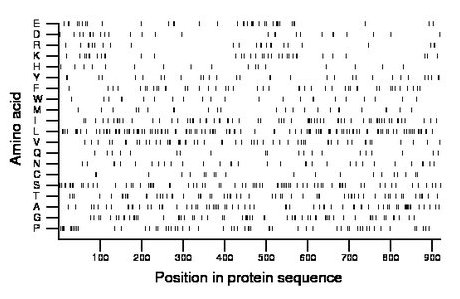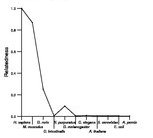
| Name: SLC14A2 | Sequence: fasta or formatted (920aa) | NCBI GI: 157694503 | |
|
Description: solute carrier family 14 (urea transporter), member 2
|
Referenced in: Kidney
| ||
|
Composition:

Amino acid Percentage Count Longest homopolymer A alanine 8.0 74 2 C cysteine 2.2 20 1 D aspartate 2.8 26 2 E glutamate 4.1 38 3 F phenylalanine 4.9 45 2 G glycine 7.2 66 4 H histidine 1.8 17 1 I isoleucine 7.3 67 2 K lysine 3.7 34 1 L leucine 12.8 118 3 M methionine 2.7 25 1 N asparagine 3.5 32 2 P proline 6.2 57 2 Q glutamine 2.2 20 1 R arginine 2.8 26 3 S serine 8.6 79 2 T threonine 6.7 62 2 V valine 5.9 54 2 W tryptophan 2.7 25 2 Y tyrosine 3.8 35 2 |
Comparative genomics:
Search single species RefSeq proteins at NCBI
Search summary 
Figure data | ||
Related human proteins:Protein Relative score Description Self-match 1.000 solute carrier family 14 (urea transporter), member... SLC14A1 0.266 solute carrier family 14 (urea transporter), member... SLC14A1 0.266 solute carrier family 14 (urea transporter), member... SLC14A1 0.266 solute carrier family 14 (urea transporter), member... SLC14A1 0.266 solute carrier family 14 (urea transporter), member... KDM4D 0.004 jumonji domain containing 2D LOC100291479 0.004 PREDICTED: hypothetical protein XP_002348186 LOC100291447 0.004 PREDICTED: hypothetical protein XP_002348185 LOC100288699 0.004 PREDICTED: hypothetical protein XP_002343846 TET3 0.004 tet oncogene family member 3 SENP7 0.003 sentrin/SUMO-specific protease 7 isoform 2 MAP1A 0.003 microtubule-associated protein 1A SPPL2B 0.003 signal peptide peptidase-like 2B isoform 3 SPPL2B 0.003 signal peptide peptidase-like 2B isoform 2 NFE2L3 0.003 nuclear factor erythroid 2-like 3 CNOT3 0.003 CCR4-NOT transcription complex, subunit 3Human BLASTP results (used to prepare the table) | |||
Gene descriptions are from NCBI RefSeq. Search results were obtained with NCBI BLAST and RefSeq entries. When identical proteins are present, the self-match may not be listed first in BLASTP output. In such cases, the table above has been reordered to place it first.
See About the Figures for the scoring system used in the figure above right. The same scoring system was used in the table of BLASTP results.
Guide to the Human Genome
Copyright © 2010 by Stewart Scherer. All rights reserved.
